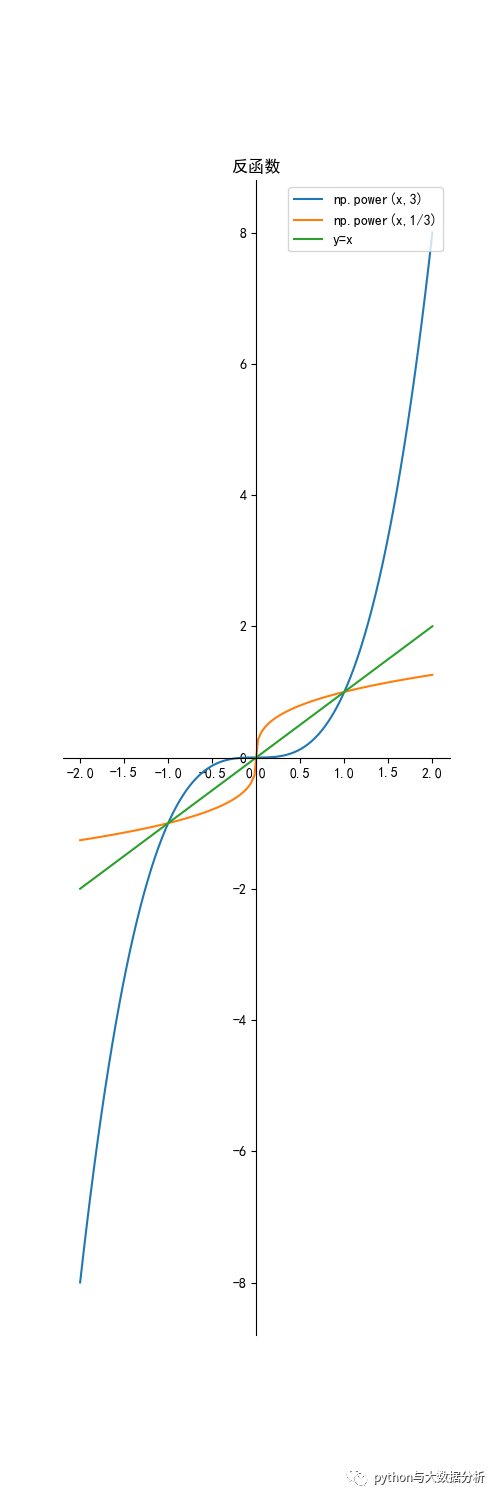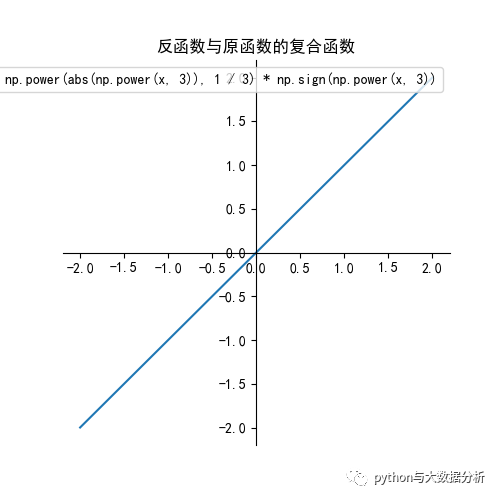本文转载自微信公众号「python与大数据分析」,作者一只小小鸟鸟。转载本文请联系python与大数据分析公众号。
一般来说,设函数y=f(x)(x∈A)的值域是C,若找得到一个函数g(y)在每一处g(y)都等于x,这样的函数x= g(y)(y∈C)叫做函数y=f(x)(x∈A)的反函数,记作x=f-1(y) 。反函数x=f -1(y)的定义域、值域分别是函数y=f(x)的值域、定义域。最具有代表性的反函数就是对数函数与指数函数。
- #!/usr/bin/env python
- # -*- coding: UTF-8 -*-
- # _ooOoo_
- # o8888888o
- # 88" . "88
- # ( | - _ - | )
- # O\ = /O
- # ____/`---'\____
- # .' \\| |// `.
- # / \\|||:|||// \
- # / _|||||-:- |||||- \
- # | | \\\ - /// | |
- # | \_| ''\---/'' | _/ |
- # \ .-\__ `-` ___/-. /
- # ___`. .' /--.--\ `. . __
- # ."" '< `.___\_<|>_/___.' >'"".
- # | | : `- \`.;`\ _ /`;.`/ - ` : | |
- # \ \ `-. \_ __\ /__ _/ .-` / /
- # ==`-.____`-.___\_____/___.-`____.-'==
- # `=---='
- '''
- @Project :pythonalgorithms
- @File :Inversefunction.py
- @Author :不胜人生一场醉@Date :2021/7/29 23:17
- '''
- import matplotlib.pyplot as plt
- import numpy as np
- if __name__ == '__main__':
- inversefunction()
- def inversefunction():
- plt.figure(figsize=(5, 15))
- ax = plt.gca() # 通过gca:get current axis得到当前轴
- plt.rcParams['font.sans-serif'] = ['SimHei'] # 绘图中文
- plt.rcParams['axes.unicode_minus'] = False # 绘图负号
- x = np.linspace(-2, 2, 100)
- y1 = np.power(x, 3)
- y2 = np.power(abs(x), 1 / 3) * np.sign(x)
- y3 = x
- label = 'np.power(x,3)'
- plt.plot(x, y1, label=label)
- label = 'np.power(x,1/3)'
- plt.plot(x, y2, label=label)
- # plt.plot(y1,x,label=label)
- # np.power(x,1/3)和x,y1调换一下是等价的
- label = 'y=x'
- plt.plot(x, y3, label=label)
- # 设置图片的右边框和上边框为不显示
- ax.spines['right'].set_color('none')
- ax.spines['top'].set_color('none')
- # 挪动x,y轴的位置,也就是图片下边框和左边框的位置
- # data表示通过值来设置x轴的位置,将x轴绑定在y=0的位置
- ax.spines['bottom'].set_position(('data', 0))
- # axes表示以百分比的形式设置轴的位置,即将y轴绑定在x轴50%的位置
- # ax.spines['left'].set_position(('axes', 0.5))
- ax.spines['left'].set_position(('data', 0))
- plt.title("反函数")
- plt.legend(loc='upper right')
- plt.show()
- # 反函数与原函数的复合函数等于x
- plt.figure(figsize=(5, 5))
- ax = plt.gca() # 通过gca:get current axis得到当前轴
- plt.rcParams['font.sans-serif'] = ['SimHei'] # 绘图中文
- plt.rcParams['axes.unicode_minus'] = False # 绘图负号
- x = np.linspace(-2, 2, 100)
- y1 = np.power(x, 3)
- y2 = np.power(abs(y1), 1 / 3) * np.sign(y1)
- label = 'np.power(abs(np.power(x, 3)), 1 / 3) * np.sign(np.power(x, 3))'
- plt.plot(x, y2, label=label)
- ax.spines['right'].set_color('none')
- ax.spines['top'].set_color('none')
- # 挪动x,y轴的位置,也就是图片下边框和左边框的位置
- # data表示通过值来设置x轴的位置,将x轴绑定在y=0的位置
- ax.spines['bottom'].set_position(('data', 0))
- # axes表示以百分比的形式设置轴的位置,即将y轴绑定在x轴50%的位置
- # ax.spines['left'].set_position(('axes', 0.5))
- ax.spines['left'].set_position(('data', 0))
- plt.title("反函数与原函数的复合函数")
- plt.legend(loc='upper right')
- plt.show()






























